Whatever the weather, it’s good to be prepared. Whether you’re looking to upgrade your existing heater with a reliable model that will last for years to come or you want to add a little help during sudden drops in temperature, having a reliable garage heater will ensure a cozy workspace all year round. The cold doesn’t discriminate, so any garage will benefit from a great heater during the winter. After all, maintaining a comfortable work environment is crucial for pleasant and efficient work.
- Features to Consider in Good Garage Heaters
- Top 10 Best Garage Heaters 2025
- 1. Best Overall Garage Heater: Heat Storm WIFI Infrared Heater
- 2. Best Commercial Garage Heater: Dr. Heater Commercial Heater
- 3. Best Budget Garage Heater: Mr. Heater Buddy Portable Propane Radiant Heater
- 4. Best Electric Garage Heater: Faranheat FUH54 Unit Heater
- 5. Best Portable Garage Heater: Mr. Heater Portable Propane Forced-Air Heater
- 6. Best Premium Garage Heater: Mr. Heater Big Maxx Natural Gas Heater
- 7. Best Kerosene Garage Heater: Dyna-Glo Kerosene Forced-Air Heater
- 8. Best Natural Gas Garage Heater: Mr. Heater Blue Flame Natural Gas Heater
- 9. Dr. Heater Infrared 6-30R Plug Heater
- 10. Best Looking Garage Heater: Aikoper Ceramic Tower Heater
- Guide to Buying the Best Garage Heater
Features to Consider in Good Garage Heaters
But you can’t just buy any heater. Garage heaters not only vary in overall quality and reliability, but in the type of space that they’re suited for, too. Before rushing off to purchase the first garage heater you see, you’ll want to take the following criteria into consideration:
Type of Heater
The type of heater that will be most suitable for your needs depends on several factors: garage size, what you use the space for, and access to utilities such as power and gas.
For smaller spaces, infrared heaters are popular as they work by heating objects rather than air. If you’re lucky enough to have a large garage, a forced-air heater will do the job more efficiently as it forces out warm air that spreads throughout the room.
Fuel operated heaters require appropriate venting, whether they’re portable or not, while electric heaters either need to be hardwired or have an appropriate outlet available.
Garage Size
The size and type of your garage play a big role in choosing an appropriate heater. A larger garage will require more power to heat it up, and also more air circulation to make sure the space is heated evenly. An uninsulated garage will require more heat to keep warm, which is neither eco friendly nor friendly to your pocket. Conversely, a well-insulated garage will be cheaper to heat, and you may be able to get away with smaller units.
Safety Features
The nature of your garage is important to consider when choosing a heater, predominantly due to safety issues that might arise. Workshops where flammable vapors are present or where there’s a lot of sawdust flying around require a heater where no sparking or combustion is taking place. As such, woodworking workshops are best off with a forced-air electrical heater. If, however, no varnishing is taking place in the garage and sawdust is kept under control, more types of heaters can be used.
Safety features such as automatic shut-offs in case of low oxygen, lack of fuel, the pilot light going out, or the heater tipping over are important to consider not only to reduce the risk of fire, but also for your own peace of mind. Other safety features, such as no-heat handles and components, are also something you may want to keep in mind. It’s particularly important to keep an eye on the carbon monoxide (CO) levels when using a fuel-operated heater. A safe heater should come with a low oxygen detector, but if they don’t it’s up to you to ensure a CO detector is installed in the room.
Legal Requirements
If you happen to live in California, Massachusetts, Canada, or a few other jurisdictions, the laws regarding heating units may be more restrictive than they are in most of the United States. Before purchasing any heater, make sure the product will be compliant with local laws.
Size and Mounting
Last but not least, you should decide whether you want a portable unit or a permanent addition to your garage. Both vertical and horizontal space are important to consider: a portable heater will sit on the floor, potentially cluttering up precious floor space, while most mounted heaters require a minimum floor-to-heater height or must be installed in a specific place. Different heaters will also have different utility requirements, such as accessible outlets or an available gas supply.
Top 10 Best Garage Heaters 2025
1. Best Overall Garage Heater: Heat Storm WIFI Infrared Heater
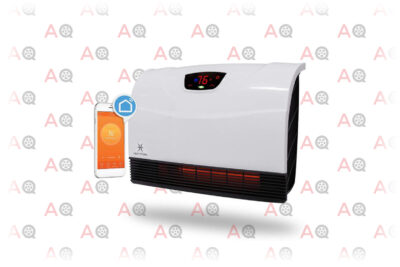
Editor’s Rating:
The sleek design of this infrared heater by Heat Storm will blend in nicely with a well-cared-for garage since it presents a more residential aesthetic than some of the more industrial looking heaters. It’s the most technologically modern heater on this list, with WiFi connectivity which enables you to preheat the garage and minimize the time you stay out in the cold.
This unit will heat a well-insulated two-car garage, with two heaters being able to keep even a three-car garage warm. The heater has an output of 1,500 W, which is equivalent to 5,200 BTUs, hence being able to heat an area of around 300 square feet.
The option given here is for wall mounting only, and the unit requires a 120 V, 60 Hz, 15 A grounded outlet. Although this heater requires wall mounting, it will not take up much space, with dimensions of 21.5 by 15.6 by 7.3 inches. The integrated thermostat enables you to set a temperature between 40 and 99° Fahrenheit, which can be done either manually on the unit itself or through the SmartLife app on your smartphone. As this is an infrared heater, it will provide you with warmth without drying out the air, resulting in a more comfortable work environment.
Even though this unit has impressive heating capabilities, the vents won’t get hot enough to burn your skin, and it even features an automatic shut-off function if it tips over. All this means you can stay nice and toasty without getting cooked.
Pros
- Perfect for smaller spaces
- Very quiet
- Can be operated remotely
- Many safety features like automatic shut-off
- WiFi enabled
Cons
- Might need two or more units for bigger spaces
- The advanced features may be unnecessary for some people
2. Best Commercial Garage Heater: Dr. Heater Commercial Heater

Editor’s Rating:
This Dr. Heater unit is similar to the Faranheat heater that appears later on our list but more powerful with a maximum output of 6,000 W, an equivalent of 20,500 BTUs. It’s an electrical heater, with an industrial look, that can heat an area of up to 900 square feet, which is around the size of a three-car garage. It will work best in insulated garages, but it will do the job in smaller uninsulated spaces.
The heater is an industrial-grade infrared heater that needs to be hardwired and mounted either on the ceiling or a wall. The unit is easy to install, however, it doesn’t feature an on/off switch–the circuit breaker has to be used to switch the heater on and off. Although it’s infrared, it does have a fan for heat dispersal as well as adjustable louvers (slats to help direct the airflow). The unit features a thermostat with two temperature options – “high”, giving an output of 6,000 W or 20,500 BTUs, and “low”, with a 3,000 W output. If desired, the heater can be combined with a separate thermostat, allowing for much better temperature control in the range of 40-90°. If your garage is uninsulated and constantly loses heat, the basic thermostat would be sufficient to maintain a comfortable working temperature.
The ceiling and wall mounting brackets are included, and despite needing to be hardwired it is easy to install. With dimensions of 14.5 by 14.5 by 13 inches and requiring a minimum mounting height of 8 feet, it is not a good option for low-ceiling garages. As this heater is fully enclosed it is great for woodworking workshops where sawdust and varnish fumes are present.
Pros
- Suitable for larger spaces
- Very powerful heat output
- Reliable and built to last for years
- Can be combined with a thermostat
Cons
- No thermostat
- No automatic shut-off in case of overheating
3. Best Budget Garage Heater: Mr. Heater Buddy Portable Propane Radiant Heater
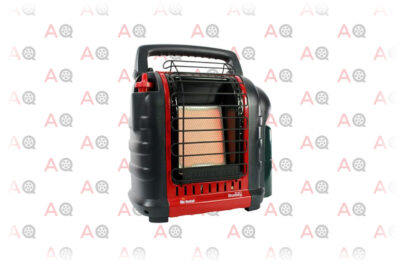
Editor’s Rating:
A product from Mr. Heater, the Buddy is a small portable heater measuring 7.7 by 13.4 by 15 inches and weighing 9 pounds. Despite its small size, it’s able to heat an insulated two-car garage of around 225 square feet. It runs on propane, which is perfect if you don’t have spare outlets or are unable to permanently mount a heater in your garage. Being portable, this heater will keep you warm on those colder days not only inside your garage, but it any other small space that needs heating, too.
The heater has basic high and low settings with 9,000 and 4,000 BTUs, respectively. It is sold ready to be hooked up to a 1-pound propane cylinder, but it can be fuelled by larger tanks with an appropriate hose and filter, which are sold separately. The integrated sparking mechanism is reliable, and the unit is quiet as it emits radiant heat that isn’t blown out with a fan.
As it’s a gas heater, which consumes oxygen, it has a built-in oxygen-depletion Sensor which will detect low oxygen and shut off to prevent the production of carbon monoxide. For this reason, the heater is only guaranteed to work up to altitudes of 7,000 feet—not an issue for most Americans, but problematic if you happen to live in a Colorado ski town. It also has an auto shut off feature if the heater is tipped over.
Using a 1-pound propane tank, your Buddy should keep you warm for up to 6 hours on the low setting and 3 hours on high. With a 5 gallon tank, it can supply heat for up to 3 days on the low setting!
Being small and portable, while beneficial, might not make this product ideal if you’re looking for something more powerful or permanent. It also only has two settings for the heat and no thermostat, meaning there are only a limited range of temperatures to choose from.
Pros
- Lightweight and portable
- Very affordable
- Cheap to run
Cons
- Not available in Massachusetts or Canada
- Not powerful enough for bigger garages
4. Best Electric Garage Heater: Faranheat FUH54 Unit Heater
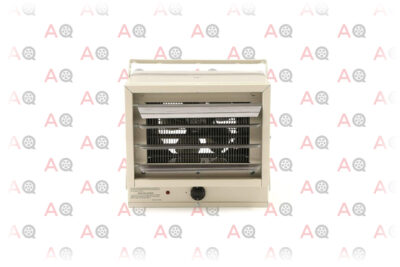
Editor’s Rating:
This electric heater from Faranheat may look like a boxy PC straight out of the early ’90s, but it can generate heat like a modern-day laptop. Ceiling mountable, it’s designed to warm up spaces of around 750 sqft, or an average two-car garage. More units can be installed to heat a larger space, but this can get quite costly. The unit has a maximum output of 5,000 W, which is an equivalent of 17,065 BTUs.
The Faranheat forced-air heater has a range of temperatures between 45 and 135° and features a 1,350 rpm fan, which helps to distribute heat while remaining quiet at the same time. It has adjustable louvers as well as a thermostat with “high” and “low” options, which give an output of 17,065 and 8,533 BTUs respectively. It’s possible to install a separate thermostat if you want to fine-tune your desired temperature, however for the price of the unit you might have hoped it would come fitted with a fully-adjustable thermostat to begin with. Not only is the unit more expensive than many others on this list, but if you’re planning to run this heater a lot it can quickly ramp up your electricity bill.
The unit needs to be hardwired and ceiling mounted at a minimum height of 6 feet, making it an appropriate choice for low ceiling garages. Although the heater is small at 12.5 by 12.4 by 14 inches and requires a low minimum mounting height, you will still need to ensure you have the space required in your garage. In terms of safety, this heater is suitable for a woodworking workshop, and it does feature an auto-shut-off mechanism in case of overheating of the unit. Overall, for the reliability and build quality this Faranheat heater is well worth the price.
Pros
- Suitable for smaller spaces
- Good range of temperatures
- Good for garages with a low ceiling
Cons
- Needs to be hardwired
- Can be expensive if you need a better thermostat or multiple units
5. Best Portable Garage Heater: Mr. Heater Portable Propane Forced-Air Heater
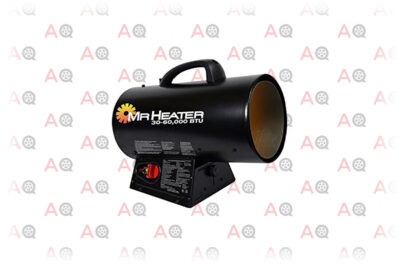
Editor’s Rating:
If you have a lot of space to heat but also want to be able to move your garage heater around from place to place, then this Mr. Heater product should do the job fantastically. This forced-air propane heater will be able to warm spaces up to 1,500 sqft, which is more than the average three-car garage. It’s perfect for garages that are drafty and uninsulated, or situations where the garage door has to stay open as you work. As the heater is portable, weighing around 13 pounds, it can easily keep you warm if you need to work outside of the garage too.
This 16 by 8.8 by 13.5 inch heater is equipped with Quiet Burning Technology (QBT), bringing the decibels down and allowing you to work without having to worry about your hearing. The product comes with a 10 foot hose and regulator for a fuss-free setup. The heater does have to be connected to a 115 V outlet and a 20 pounder propane tank or larger, so while it is portable within range of the garage, you won’t be able to take it with you for your next camping trip unless you’re able to give it both propane and electricity there. As it uses up oxygen at a phenomenal rate, good ventilation is required to minimize carbon monoxide production.
The heater doesn’t have a thermostat, with only two options for the temperature–“high” and “low”. With an output of 30,000 BTUs on low and 60,000 BTUs on high, it can run up to 14 hours on the low setting with a 20-pound propane tank. With such a great heat output, however, it can be used alongside another smaller heater, where this propane heater will be able to rapidly bring the temperature up after which it can be switched off, leaving the smaller heater to simply maintain the desired temperature.
Pros
- Can heat a large area
- Small, light, and portable
- Cheap to run
- Affordable
Cons
- Quite loud despite the QBT
- Good ventilation is a must
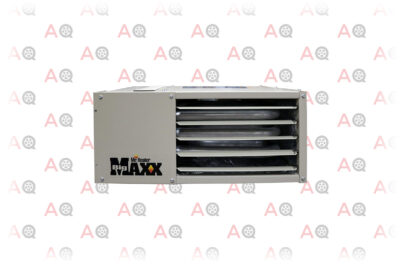
Editor’s Rating:
This monster of a heater can supply you with 50,000 BTUs heating a space of up to 1,250 square feet, an equivalent of more than a large three-car garage. The heater is fuelled by natural gas, meaning it requires appropriate venting and a 115 V AC supply as well as the gas supply itself. It is a serious piece of equipment with a serious price tag.
Despite the massive amount of BTUs, this natural gas heater has a range between 35 and 75°, which isn’t anything to write home about but certainly enough to keep a workspace comfortably warm. A thermostat is also sold separately. It requires category 1 negative pressure and non-condensing vertical venting, as well as category 3 positive pressure, non-condensing horizontal venting. As it requires proper venting, it doesn’t come with a low oxygen sensor, and so investing in a carbon monoxide detector is highly advisable.
Measuring 25 by 18.5 by 17 inches, it would appear to have a low profile suitable for lower ceilings. However, this is not the case, as an 8-foot clearance from the floor to the base of the heater is required. The heater weighs a hefty 63 pounds, and it’s best if an experienced engineer does the installation.
As it is a forced-air heater, it will distribute heat throughout the space and will be best for large garages. The venting kit that’s required is sold separately, further adding to the cost of the unit. The product does come with a natural-gas-to-propane conversion kit if you’d like your new appliance to run on propane instead. It’s relatively quiet for its performance, maxing out at 55 decibels. As it’s not a closed combustion unit, it is not recommended for woodworking workshops where vapors and sawdust are present.
Pros
- Great for large spaces
- Powerful and reliable
- Quiet for such a powerful heater
Cons
- Expensive, especially when you consider that it doesn’t include a venting kit or thermostat
7. Best Kerosene Garage Heater: Dyna-Glo Kerosene Forced-Air Heater
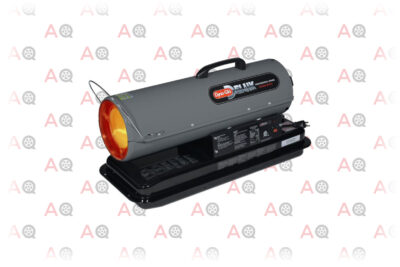
Editor’s Rating:
Although this is the smallest version of the Dyna-Glo kerosene heater, it still comes in at a rating of 50,000 BTUs. That kind of output is able to heat a three-car garage easily. For those out there wanting a mini jet engine, or needing to heat up their personal hangar, up to 180,000 BTUs options are available, with the biggest one heating warehouses up to 4,200 square feet.
The unit has a runtime fuel gauge and a pressure gauge to keep you updated on the functioning of the heater. It has a fuel capacity of 5 gallons, equating to about 14 hours of heat. The heater has a cool to the touch handle for safe repositioning, as well as an automatic-shutoff feature for if it overheats or runs out of fuel. These Dyna-Glo products will eat through huge volumes of oxygen, and so are not at all suitable for small or enclosed spaces.
This series of products has been designed to be used with the following types of fuel: K1 kerosene, diesel #1, diesel #2, fuel oil #1, fuel oil #2, Jet A and JP-8. However, K1 kerosene is the manufacturer’s recommended fuel for optimal, cleaner burns and long-lasting product life.
Pros
- Huge heat output
- Can be used with a wide range of fuels
- Portable while being extremely powerful
Cons
- Requires great ventilation
8. Best Natural Gas Garage Heater: Mr. Heater Blue Flame Natural Gas Heater
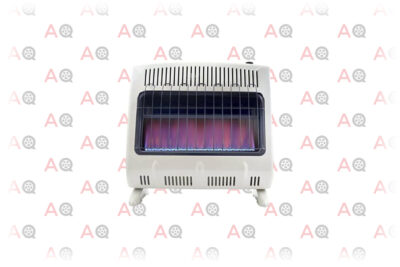
Editor’s Rating:
This natural gas vent-free heater from Mr. Heater is quite powerful, being able to heat a large two-car garage or around 750 square feet. Measuring 23.8 by 11.2 by 27 inches, it comes with legs and wall-mounting hardware, so you can decide on the best option for your garage. It’s a great natural gas option that’s perfect if you have a gas line available in your garage.
The heater has an output of 30,000 BTUs, which should be plenty for mid-sized insulated garages. No external power is required to operate this heater, as the electronic ignition is battery powered. It has a basic thermostat with 5 settings, ranging from 60 to 118° in increments of roughly 15°. This heater does require a 3/8” NPT inlet connection to the pressure regulator, and a 3/8” NPT street elbow is required if you’re using feet to mount it on the floor.
As is standard for gas heaters, it has a low oxygen shut-off system guaranteed to work at altitudes up to 4,500 feet–something to keep in mind if you live in one of the more elevated states. It is a blue flame heater, meaning that it produces convection heat to warm the air above the unit. If you want to have the warm air directed away from the ceiling, you will need to buy the blower for the unit.
This heater needs to be connected to a utility gas well, so it is recommended that you have a qualified service person install it.
Pros
- Odorless operation
- Cheap to run
- Great heat output
Cons
- Blower sold separately
- Unavailable in California
9. Dr. Heater Infrared 6-30R Plug Heater

Editor’s Rating:
Another product manufactured by Dr. Heater, this one is an electric portable infrared heater. If your garage has a spare NEMA 6-30R receptacle, then this heater is perfect for the job. Designed to heat spaces of around 600 square feet, it will easily heat a two-car insulated garage and definitely take the chill off a bigger space or an uninsulated garage. The heater has an output of 5,600 W, which is equivalent to about 19,000 BTUs. It measures 12 by 12 by 15 inches and weighs 18 pounds.
This infrared unit will heat people and surrounding objects, not the air directly, providing a comfortable working environment. The heater does have a fan, however, to further disperse the heat and make the heating process faster by circulating the air in the room. It’s very quiet, at 45 decibels, while still being able to heat a room to a temperature of 45 to 95°F. It also features overheat cut-off protection to ensure that the operation of the unit remains safe.
This product comes with a 6-foot power cord with a 6-30R plug, which requires a 240 V NEMA 6-30R receptacle. This can either be a pro or a con for you, depending on whether you already have such a receptacle in your garage. The heater does have a thermostat built-in, however, it is very basic and can be fiddly to use. As it has a sparking mechanism, it is not advisable to use it around paints and other flammable liquids and vapors.
Pros
- Portable and easy to handle
- Very quiet
- Provides comfortable heat
Cons
- Thermostat can be difficult to use
10. Best Looking Garage Heater: Aikoper Ceramic Tower Heater

Editor’s Rating:
If floor space is at a premium and you require a unit that fits in with your decor, the Aikoper ceramic space heater could be the one for you. It is an oscillating tower heater that will do well in a small insulated garage, and due to its looks and size, you can also use it around the house if needed. With a power output of 1,500 W (or 5,120 BTUs), it is a small forced-air heater measuring 8.1 by 7.6 by 24.1 inches and weighing a little under 7 pounds, which will be suitable for spaces up to 225 square feet.
The unit has a “low” setting with an output of 900 W, a “high” setting which outputs 1500 W, and an eco mode that automatically adjusts the temperature, saving you money. A thermostat is present so you can adjust the temperature between 40 and 95°F, and the oscillation feature will help to disperse the heat and warm the room evenly.
Unlike some other products on the market, this unit is made of a flame retardant material and is robust enough to not melt and pose an unnecessary fire risk. In case you do forget to switch the heater off, the unit has an 8-hour timer after which the heater will turn off. The product comes with a remote control which enables you to operate the heater from a distance. This heater also features overheat and tip-over protection where the unit will automatically switch off.
Pros
- Affordably priced
- Lightweight and easy to move around
- Versatile around the house
- Looks great
Cons
- Effective in small spaces only
- Low power for a garage
Guide to Buying the Best Garage Heater
What Type of Garage Heater Should I Get?
The vast majority of heaters can be classified into two categories–infrared and forced-air. The type of heater best suited for your needs will highly depend on your garage size as well what your garage is used for.
Infrared
Heaters that use infrared heating work by indirectly heating the room, resulting in a more comfortable working environment. The infrared system heats objects—including people—via electromagnetic radiation rather than directly heating the air. The heated objects then emit heat, warming the air around them and increasing the ambient temperature. Infrared heaters can still have fans installed to enable movement of the warmed air away from the objects, further helping to evenly distribute the heat.
As these heaters warm the air indirectly, they are best suited for smaller spaces where items are present. Since objects get heated by infrared heaters, these heaters will not be suitable for workshops with a lot of sawdust or other flammable materials.
Forced-Air
Forced-air heaters have a heating element in their construction that warms up to very high temperatures and heats the air around that element. The fans in the heater then blow the hot air out into the room. Thought this is an effective heating method, it often dries out the air.
As the hot air is constantly blown into the room, these heaters work best in large spaces, and the contents of the room don’t matter much in terms of a direct fire risk.
What Type of Fuel Is Best for a Heater?
Different heaters are designed with different purposes in mind, and as such the fuel used will reflect that. The best type of fuel for you will depend on your needs, the utilities available in your garage, as well as the nature of your workspace. Below we’ve outlined the most common fuel categories in the US—electricity, gas, and liquid fuels, giving the pros and cons of each.
Electric Heaters
The electric heater is considered to be the safest fuel for heaters, as no fumes are produced and no combustion is taking place. They are, however, more expensive to run compared to gas and liquid fuel options.
Although they are considered to be safer, they’re still a fire hazard, and like all types of equipment, they require maintenance. An electric heater still needs to be installed correctly according to the instructions from the manufacturer, as well as general electrical safety precautions.
Whether you pick a portable option or a unit that’s hardwired, the heater should not be operated close to flammable materials. On top of that, maintaining your garage and keeping it tidy and clutter-free will also reduce the risk of something catching fire.
Gas Heaters
Gas heaters are a common option. Many of these heaters can be powered by propane tanks, making them a popular choice even in areas without access to a natural gas utility line. They are cheaper to run than electric heaters, however, they are also more demanding in terms of safety and maintenance.
As gas heaters use combustion to produce heat, they require a constant supply of oxygen to keep the reaction going. This requires a well-ventilated area or a good venting system to avoid carbon monoxide production and potential poisoning. Regardless of product safety features such as low oxygen detectors, it’s crucial to have a CO detector installed in any room with a gas heater.
These heaters also are not suitable for workshops where other potential fuels might be found such as paints, varnishes, and aerosols.
Liquid Fuel Heaters
Heaters using liquid fuel such as kerosene, diesel, or jet fuel are slightly less common and are definitely best used in industrial spaces or the outdoors. Just like gas heaters, they can produce carbon monoxide, but they will also smoke to some extent as exhaust products are produced and emitted from the combustion process.
Due to the nature of liquid fuel heaters, they require very good ventilation and would be more suited to a large garage that is kept open to prevent CO poisoning. Again a carbon monoxide detector is a must.
What Are the Power Ratings About?
There are various ways to report the power output of a heater, but the most common units are watts and BTU/h. While manufacturers report the power output of their products, they don’t necessarily share the efficiency of the unit. While shopping for the best heater for your needs, you should assume about 80% efficiency of the heater–this number can get as low as 60% efficiency and some more modern heaters can work at around 90% efficiency, but this is generally a safe default assumption.
Watts
Electric heaters report the heating output in watts which is a unit of power that is defined as the rate of energy transfer. How efficiently an object is heated will depend on the material the object is made from, meaning that the same heater can heat different garages of the same size at different rates depending on the surroundings, humidity, and outside temperature.
BTU
The British Thermal Unit (BTU) is a unit of heat defined as the amount of heat required to raise the temperature of one pound of water by one degree Fahrenheit, roughly equating to 1.055 kJ. Determining how many BTUs your garage needs depends on the volume of your garage as well as the surroundings of the space, for which we included a basic guide below. While the correct unit is technically BTU/h, many companies simply use the unit BTU to mean the same thing. To approximate, 1 watt is around 3.4 BTU/h.
How Loud Is Too Loud?
Depending on your working environment, the volume of a heater can be important. If your shop is constantly noisy, the hum of a heater will hardly have an impact. If you like to work in silence or while listening to music, and you don’t often use power tools, the whirr of a fan or a thermostat switching on and off with a loud click can get annoying. Many of the heaters on this list have a rating between 45 and 55 decibals, which is roughly equivalent to the noise level of a running household refrigerator.
Mounting and Portability Considerations
Whether to get a portable unit or not will again depend on your personal needs around the garage. Portable units can be versatile, but mounted heaters will be perfect if you’re looking for fuss-free operation.
Freestanding Heaters
Freestanding heaters tend to be portable and are great if you’re not tight on floor or desk space. They are also very useful if you like to work in other locations as well as in your garage. They are very versatile and can give you a warm helping hand where you need it. Gas- or fuel-operated ones are particularly portable as you don’t have to rely on an outlet being available close to where you’re working. Since they’re not mounted they can tip over, causing the heater to switch off. For this reason you have to ensure they’re on an appropriate and safe surface every time you use a freestanding heater.
Mounted Heaters
A mounted heater is a more permanent addition to your garage. They can be either hardwired, fuel operated, or get power from a nearby outlet. With a mounted unit you’ll need to make the effort to ensure the safety and logistics once upon installation, and from then on you’ll have have the freedom of simply switching your heater on and off each time you need to use it. They tend to have precise requirements as to the power supply, ventilation, and horizontal and vertical distances from other objects.
Garage Sizes
The size of the average American garage can vary by a huge amount, but the most common sizes are single-car, 2-car, and 3-car garages.
When heating your garage, it’s not just about floor space—the ceiling height plays an important role too, as you’re trying to heat the entire volume of your garage. A low ceiling around eight feet high will reduce the volume to be heated, while a taller ceiling will increase the volume, hence requiring more power from the heater to efficiently heat the space. On average, the ceiling height of most garages tends to be around 10 feet.
To find out which heater is appropriate for you, you should consider how big your garage is, the purpose of the workspace, your insulation, and the climate where you live on top of your space’s square footage. If your garage is somewhere between sizes, then these factors are increasingly important. If you’re unsure, take the floor size of your garage and compare it to the ranges given below and see if you are on the smaller or larger end of the heating requirement.
| Type | Average size in sqft | Average BTUs required |
| 1 car | 264 to 336 | 50,00 to 9,000 |
| 2 car | 360 to 484 | 10,000 to 30,000 |
| 3 car | 704 to 1,200 | 20,000 to 50,000 |
You can get away with a smaller heater if:
- You live in a warm climate
- Your garage has a low ceiling
- Your garage is well insulated
Opt for a bigger heater if:
- You live in a cold area
- Your garage has an above-average ceiling height
- The garage has either poor insulation or no insulation at all
If you’re still unsure, you can either get a smaller heater to check how well it does and then buy another unit if it’s not enough, or just buy a bigger heater. After all, you can keep the larger heaters on their lower settings if need be, so it’s normally better to go too big than too small.
The most important thing to keep in mind is that no single garage heater is the best choice for everyone, so be sure to take your needs into consideration before making your purchase. Whether you’re looking for a small portable gas-powered heater for a tiny one-car garage or a massive electric heater to warm up a warehouse-sized space, we’re sure you’ll find a garage heater on this list that suits you.


